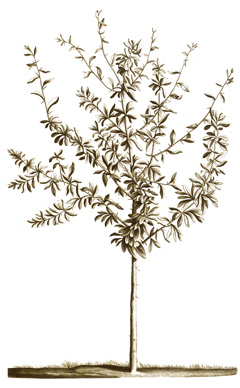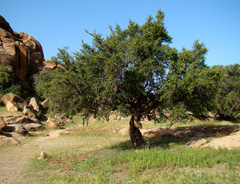 |
|
https://edibleplants.org/ |
 |
| http://bjornfree.com/galleries.html |
Translate this page:
Summary
Argan tree or Argania spinosa is a medium-sized, spiny evergreen tree commonly grown in Southwest Morocco for its highly valuable oil. It usually grows up to 10 m high with a trunk diameter of up to 100cm. It has small and oblong leaves that occur in clusters, small flowers that are yellow green in colour, and fruits that are hard and green. Argan seed oil is rich in vitamin E and can lower blood cholesterol levels, stimulate blood circulation, facilitate digestion, and strengthen the body’s natural defences. It can also be used in treating chicken pox and juvenile acne, and in removing stretch marks. The oil is also edible. It can be mixed with almonds and honey, or wheat germ and honey. Argan tree can be planted to prevent soil erosion due to its extensive root system. It also serves as wind breakers and is used for fencing. Its wood is very hard, heavy, and durable thus it is used in carpentry. It also makes a quality fuel and charcoal. Argan tree is drought-tolerant and frost-tolerant.
Physical Characteristics

 Argania spinosa is an evergreen Tree growing to 7 m (23ft) by 12 m (39ft).
Argania spinosa is an evergreen Tree growing to 7 m (23ft) by 12 m (39ft).
See above for USDA hardiness. It is hardy to UK zone 10. The flowers are pollinated by Bees, Butterflies.
It is noted for attracting wildlife.
Suitable for: light (sandy), medium (loamy) and heavy (clay) soils and can grow in nutritionally poor soil. Suitable pH: mildly acid, neutral and basic (mildly alkaline) soils. It cannot grow in the shade. It prefers moist soil and can tolerate drought.
UK Hardiness Map
US Hardiness Map
Synonyms
Argania sideroxylon Roem. & Schult. Sideroxylon argan (Retz.) Baill. Sideroxylon spinosum L. Verlang
Plant Habitats
Edible Uses
Edible Parts: Fruit Leaves Oil Seed
Edible Uses: Chocolate Oil
Edible portion: Nut - oil, Leaves, Fruit. An edible oil is obtained from the seed [ 418 ]. The white seeds contain up to 50% of a light brown oil[ 303 ]. This oil is an excellent source of vitamin E, and has a high nutritional value in the human diet. The locals mix oil with almonds and honey to make an almond butter; it also mixed with wheat germ and honey to make gruel[ 303 ]. The residue from the kernels, after oil extraction, is a thick chocolate-coloured paste called 'amlou' which is sweetened and served as a dip for bread at breakfast time in Berber households. Its flavour is similar to that of peanut butter [ 303 ]. The fruit are pressed for the oil which has an aroma and is used in cooking. The oil is cold pressed from the fruit. The oil is used like olive oil for cooking, frying and salad dressing.
References More on Edible Uses
Medicinal Uses
Plants For A Future can not take any responsibility for any adverse effects from the use of plants. Always seek advice from a professional before using a plant medicinally.
Anticholesterolemic Digestive Tonic Vasodilator
The oil from the seeds is rich in vitamin E and has properties which lower blood-cholesterol levels, stimulate circulation of the blood, facilitate digestion and strengthen the body's natural defences. It is used as a cure for chicken pox, to treat juvenile acne and help remove stretch marks on pregnant woman[ 303 ].
References More on Medicinal Uses
The Bookshop: Edible Plant Books
Our Latest books on Perennial Plants For Food Forests and Permaculture Gardens in paperback or digital formats.

Edible Tropical Plants
Food Forest Plants for Hotter Conditions: 250+ Plants For Tropical Food Forests & Permaculture Gardens.
More

Edible Temperate Plants
Plants for Your Food Forest: 500 Plants for Temperate Food Forests & Permaculture Gardens.
More

More Books
PFAF have eight books available in paperback and digital formats. Browse the shop for more information.
Shop Now
Other Uses
Charcoal Fencing Fuel Lighting Oil Shelterbelt Soap making Soil reclamation Soil stabilization Wood
Other uses rating: Medium (3/5). Agroforestry Uses: Argania spinosa shields thin soils from erosion, especially in overgrazed lands. Its deep roots help to bind the soil, facilitate water infiltration and replenish groundwater, thus helping to stabilise environmental conditions[ 303 , 418 ]. The tree provides valuable shade for humans and livestock as well protecting pasture grasses from the extreme evapotranspiration that would result from direct exposure to sunlight[ 303 ]. Argan woodlands form a green belt that functions as a buffer against desert advancement in southern Morocco[ 303 ]. The plant is used for fencing and windbreaks Other Uses: An oil obtained from the seed is used for lighting and to make soap[ 418 ]. The wood is very hard, heavy and durable. It is very resistant to damage from wood-eating organisms[ 303 ]. It is used in carpentry, for making agricultural implements and building poles[ 418 ]. The wood is a good fuel and makes a very good charcoal[ 303 , 418 ]. The seed shells are also burnt as a fuel[ 303 ]. Suitable for xeriscaping
Special Uses
Carbon Farming Coppice Food Forest
References More on Other Uses
Cultivation details
Management: Standard New Crop Staple Crop: Oil
A plant of very arid areas, mainly in the subtropical areas of northwest Africa, but just entering the tropics in Mauritania, where it is found at elevations up to 1,500 metres [ 418 ]. It grows best in areas where annual daytime temperatures are within the range of 20° - 30°c, but can tolerate 10° - 35°c[ 418 ]. Mature plants can be killed by temperatures of -2°c or lower, but new growth is severely damaged at 0°c[ 418 ]. It prefers a mean annual rainfall in the range of 200 - 300mm, but tolerates 100 - 400mm[ 418 ]. Requires a sunny position[ 418 ]. Succeeds in a wide range of soils, including very poor, dry soils[ 418 ]. The tree is well suited to calcareous soils, sandy deposits and relatively poor semi-desert soils conditions but not drifting sands or water-logged soils[ 303 ]. Prefers a pH in the range 6.5 - 7.5, tolerating 6 - 8[ 418 ]. Established plants are very drought tolerant - they can shed their foliage and remain in a state of dormancy for several years during prolonged droughts[ 418 ]. Trees may start to bear when 5 - 6 years old from seed, and reach maximum production at the age of 60 years[ 418 ]. The average fruit yield maybe about 8 kg per tree[ 418 ]. A long-lived species, with trees living for 200 - 400 years[ 418 ]. Trees respond very well to coppicing[ 303 ].
Carbon Farming
-
Management: Standard
Plants grow to their standard height. Harvest fruit, seeds, or other products. Non-Destructive management systems.
-
New Crop
Most new crops were important wild plants until recently, although some are the result of hybridization. They have been developed in the last few, decades. What they have in common is that they are currently cultivated by farmers. Examples include baobab, argan, and buffalo gourd.
-
Staple Crop: Oil
(0-15 percent protein, 16+ percent oil). Some of these are consumed whole while others are exclusively pressed for oil. Annuals include canola, poppyseed, maize, cottonseed, sunflower, peanut. Perennials include high-oil fruits, seeds, and nuts, such as olive, coconut, avocado, oil palm, shea, pecan, and macadamia. Some perennial oil crops are consumed whole as fruits and nuts, while others are exclusively pressed for oil (and some are used fresh and for oil).
References Carbon Farming Information and Carbon Sequestration Information
Temperature Converter
Type a value in the Celsius field to convert the value to Fahrenheit:
Fahrenheit:
The PFAF Bookshop
Plants For A Future have a number of books available in paperback and digital form. Book titles include Edible Plants, Edible Perennials, Edible Trees,Edible Shrubs, Woodland Gardening, and Temperate Food Forest Plants. Our new book is Food Forest Plants For Hotter Conditions (Tropical and Sub-Tropical).
Shop Now
Plant Propagation
Seed
Other Names
If available other names are mentioned here
Argan tree or Argania spinosa
Native Range
AFRICA: Algeria, Morocco.
Weed Potential
Right plant wrong place. We are currently updating this section.
Please note that a plant may be invasive in one area but may not in your area so it's worth checking.
None Known
Conservation Status
IUCN Red List of Threatened Plants Status : This taxon has not yet been assessed.

Growth: S = slow M = medium F = fast. Soil: L = light (sandy) M = medium H = heavy (clay). pH: A = acid N = neutral B = basic (alkaline). Shade: F = full shade S = semi-shade N = no shade. Moisture: D = dry M = Moist We = wet Wa = water.
Now available:
Food Forest Plants for Mediterranean Conditions
350+ Perennial Plants For Mediterranean and Drier Food Forests and Permaculture Gardens.
[Paperback and eBook]
This is the third in Plants For A Future's series of plant guides for food forests tailored to
specific climate zones. Following volumes on temperate and tropical ecosystems, this book focuses
on species suited to Mediterranean conditions—regions with hot, dry summers and cool, wet winters,
often facing the added challenge of climate change.
Read More
Expert comment
Author
(L.) Skeels
Botanical References
Links / References
For a list of references used on this page please go here
A special thanks to Ken Fern for some of the information used on this page.
Readers comment
| Add a comment |
|
If you have important information about this plant that may help other users please add a comment or link below. Only comments or links that are felt to be directly relevant to a plant will be included. If you think a comment/link or information contained on this page is inaccurate or misleading we would welcome your feedback at [email protected]. If you have questions about a plant please use the Forum on this website as we do not have the resources to answer questions ourselves.
* Please note: the comments by website users are not necessarily those held by PFAF and may give misleading or inaccurate information.
To leave a comment please Register or login here All comments need to be approved so will not appear immediately.
|
Subject : Argania spinosa
|
|
|
|